Estate Jewelry: (Partial) Maritime Edition
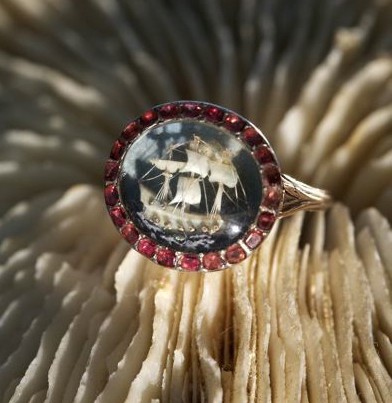
Due to its fragility, this beautiful ring is also a rarity. Circa 1790, it features a tiny, hand-carved ivory ship set under crystal. A frame of garnets surrounds the crystal, and the waves beneath the ship are hand-painted. Popular during the late 18th and early 19th centuries, pieces like this were carved by specialists predominately located in Germany, Switzerland, and France.
Some European-trained craftsmen also set up shop in England, and this ring may have originated there; it’s similar to a ring in the collection of the British Museum that resembles the work of successful ivory sculptors G. Stephany and J. Dresch. (It’s difficult to tell for sure, as many ivory carvings weren’t signed.) Stephany and Dresch were from Germany and worked in London in the 1790s, where their pieces attracted the favorable attention of King George III. This ivory panel, which was sold at Christie’s in 2008, does actually have their signatures, and is a great example of the quality of their work.
In general, ivory is super fragile, so few pieces of this delicacy have survived to the present day.
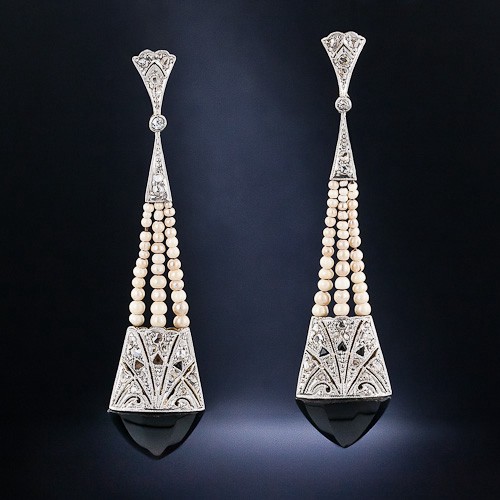
These elegant Art Deco screw-back earrings feature bases of rose-cut diamonds and faceted onyx, suspended by three seed pearl strands. The settings are platinum-coated gold. Very Lady Mary.
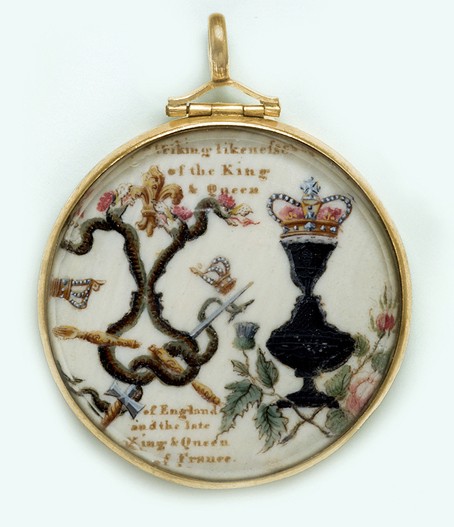
Stating that it bears the “Striking likeness of the King & Queen of England and the late King & Queen of France,” this 18th-century pendant depicts, in hand-painted ivory, the political situation in England and France during the French Revolution. On the left, the base supporting the emblems of the French monarchy — the fleur de lis, crown, and sceptre — has split apart, becoming a dual serpent/basilisk-like thing with four heads. The basilisk has sliced the sceptre and crown in half with a sword, and is devouring the fleur de lis. On the right, the thistle, rose, and crown of Great Britain stand strong and unmolested, with a solid support base. I hadn’t thought a piece of jewelry could be smug, but there you go.
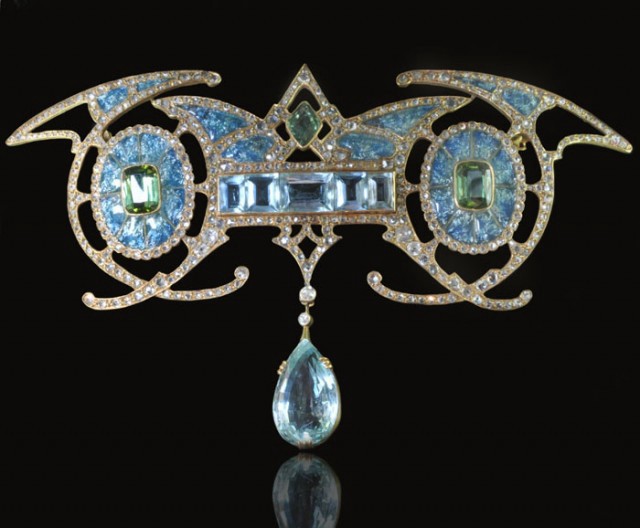
Circa 1901, this Art Nouveau brooch pairs aquamarine (approximately 29 carats total weight) and green tourmaline (approx. 9 cts t.w.) with 408 diamonds in an 18k gold setting. It is signed by French jeweler Georges Fouquet, whose work I’m pretty sure I’ve featured here more than any other designer. I think you can see why.
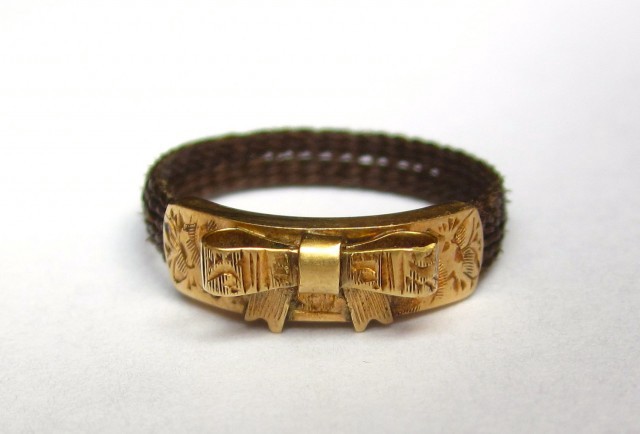
Circa the 1860s to 1880s, this ring pairs an engraved 10k gold bow with a band of woven hair. You guys know by now that mourning jewelry usually incorporated human hair — often that of the beloved — but as time passed, hairwork pieces gained a popularity all their own, eventually becoming so desirable during the 19th century that they could be purchased from the Sears catalog. Hairworking also became a genteel pastime, and many women would purchase hair or use their own (or their family members’) to weave their own creations, using patterns from popular magazines or guidebooks.
These intricately woven patterns may have originated in Våmhus, Sweden, around the middle of the 19th century; it hasn’t been firmly established that the technique was actually developed there, but it is known that a group of women who excelled at the technique travelled to England and Europe at this time to promote and sell it. The women of this area are still creating hair jewelry today.
As time moved on, intricate hairwork jewelry became less of a sentimental keepsake and more of a fashionable bauble. This particular ring could be either, as bows are a symbol of love and eternity.
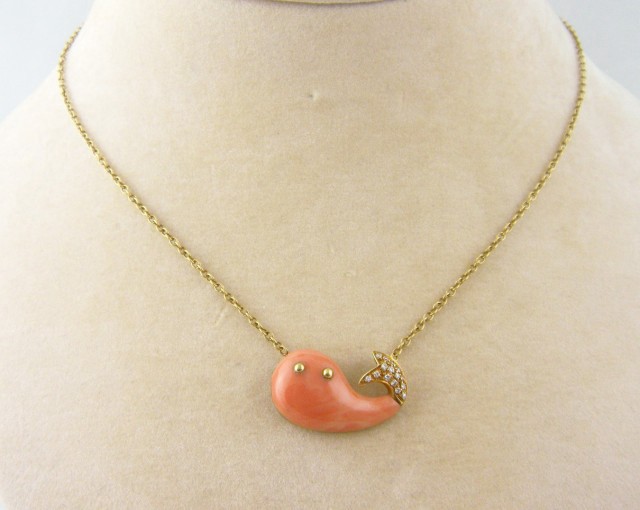
This ridiculously cute little coral whale was made by the luxury jewelry house Fred Paris. Launched in 1936 by Fred Samuel, the company’s modern aesthetic was embraced throughout the decades by celebrities such as Marlene Dietrich and Grace Kelly. (Trivia: the ruby necklace worn by Julia Roberts in Pretty Woman is by Fred Paris; it was made specifically for the film.) The company was bought by LVMH in 1995, and is still going strong today.
This whale is pretty low-key, glitz-wise, but is adorable nonetheless. Set in 18k gold, he has tiny gold studs for eyes, and a diamond-set tail.
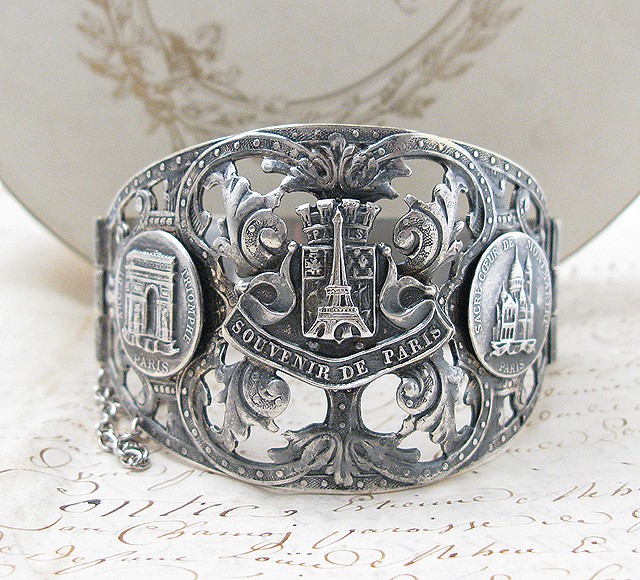
This “Souvenir de Paris” bracelet dates to the 1920s, and features central representations of the Eiffel Tower, a crown and the crest of Paris among openwork scrolled and foliate motifs. At each side is an applied medallion depicting (at left) the Arc de Triomphe and (at right) Sacre Coeur. The bracelet is silver over metal, and is hinged.
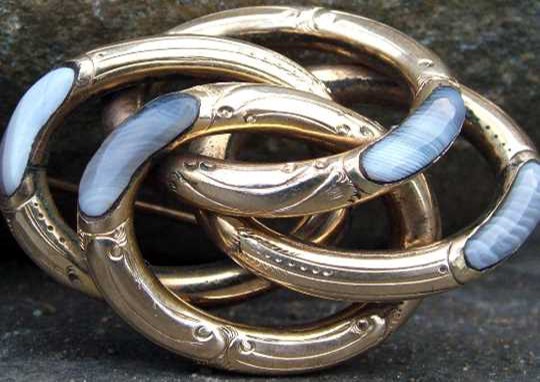
You guys always indulge my tangents of enthusiasm, and for that I can’t thank you enough. This doesn’t mean I won’t impose on you again, though. So: AGATE. I love agate! Technically, it’s a form of silica (usually chalcedony) found within volcanic or metamorphic rock, but the variations of colors streaking through its depths are always interesting, and they can sometimes be staggeringly beautiful. I talked about Scottish agate a while back, describing how Queen Victoria prompted a surge in the stone’s popularity when she and Prince Albert set up house in Scotland.
There are many variations of agate, and they can be very distinctive. This Lover’s Knot (a.k.a. “Endless Knot”) brooch features Montrose agate set in gold-plated silver. This form of agate is native to the Scotland’s coastal Montrose area (just north of Dundee), and features cool shades of gray and blue — a departure from the reds and browns seen in some other agates. This brooch dates to circa 1890, and balances the warm tones of the gold with the cooler shades of the agate.
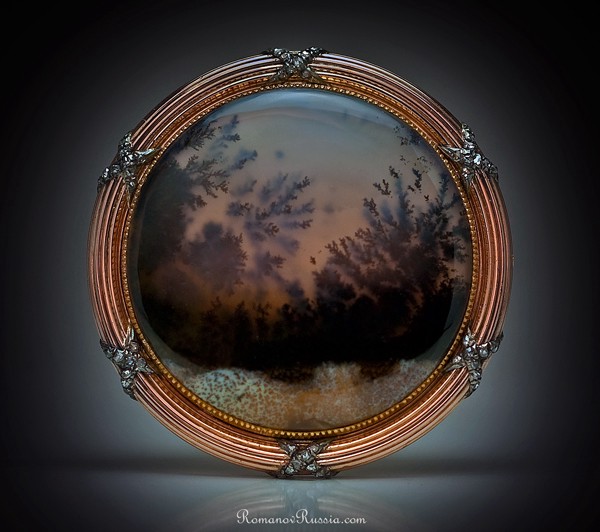
Montrose agate is probably my second favorite agate, though. Take a look at moss agate. In this form (which is found in various places, including Scotland, the US and India), greenish moss- or tree-like mineral filaments (usually manganese or iron oxide) run throughout the chalcedony. As a result, this type of agate is often referred to as “landscape agate” — and it can be really, really gorgeous.
This Russian moss agate brooch is pretty much the best there is. Circa 1908–1917, it’s Fabergé; created by their famed head workmaster Henrik Wigström. The agate plaque, which resembles a dense forest, is set within a Neoclassical-style reeded rose gold frame with diamond accents.
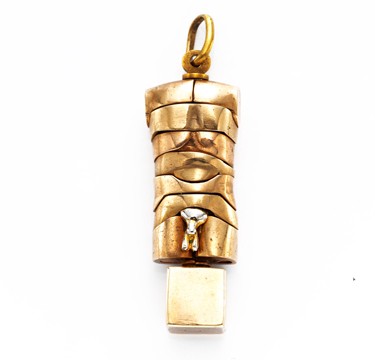
When I first saw this pendant, my immediate thought was “Hee!” But then I googled the designer, Miguel Berrocal, and swiftly found myself down a rabbit hole of sculpture and puzzle design and engineering and wow, I really should have known about this man. Berrocal (1933–2006) was a Spanish artist who specialized in puzzle sculpture, both monumental and tiny. He had a background in architecture, and was deeply interested in the structure of sculpture — not so much focusing on the exterior as the interior, or the parts that make up the whole.
This pendant, “Micro David-Off,” is made of bronze and is circa 1970. It’s a smaller version of a larger sculpture, and while it looks relatively simple from the outside, it actually has 17 pieces (the larger version contains more) that connect from the bottom up to form the body. It’s not mentioned on this site, but other Micro David-Off pendants conceal a tiny red interior gemstone that represents his heart. Also, his, erm, package can supposedly become a ring when the pendant is taken apart, but I haven’t been able to find any images of how that actually works.
So basically I’m still thinking “Hee!,” but now it’s a much better informed and appreciative “Hee!”
If you’re interested, this article from the April 1999 issue of Sculpture Magazine provides a more in-depth view of Berrocal’s work.
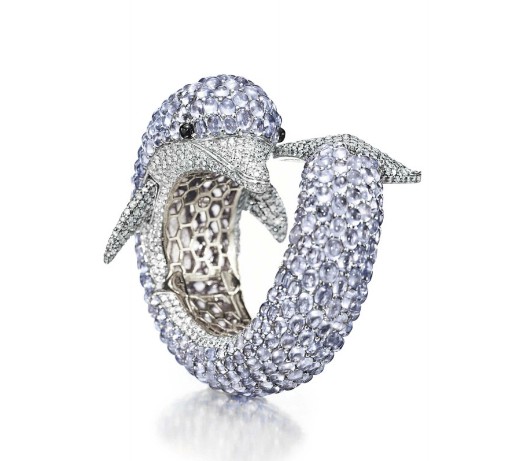
Christie’s New York’s Magnificent Jewels auction on October 16 is, as usual, a treasure chest of big names and even bigger diamonds, and there’s also a really lovely Cartier double-strand natural pearl necklace with a Type IIa diamond clasp, estimated at $2,800,000 — $3,500,000. Yow.
I love this dolphin bangle, though. By the relatively young (founded in 1993) Swiss luxury jeweler De Grisogono, it’s a hinged bangle set with cabochon sapphires and circular-cut diamonds in 18k white gold — and as if it weren’t cute enough, the flippers MOVE.
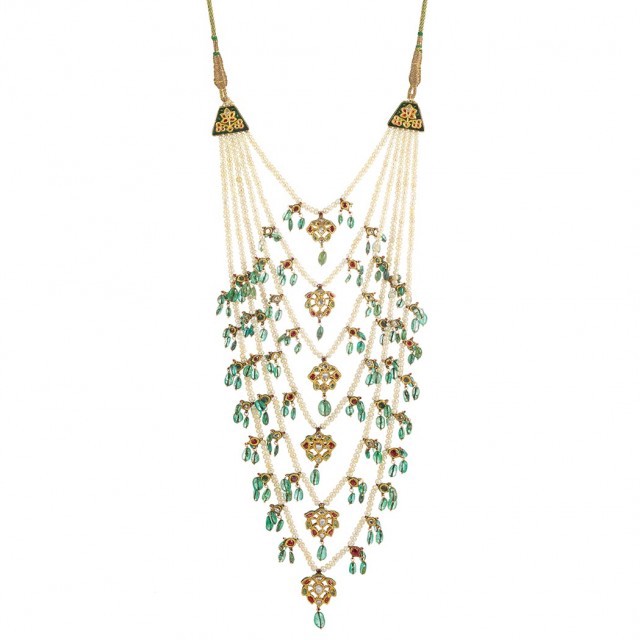
There are also some lovely pieces available in Doyle New York’s Important Estate Jewelry auction on October 17, including a collection of Indian jewelry. This Indian necklace features six graduating strands of pearls, with central openwork plaques set with foiled-back colored stones and finished with an emerald drop. Running up the sides of the strands are little pear-shaped plaques, each one containing a diamond, ruby or emerald, and from which hang three emerald beads. The back of the necklace is just as pretty, as the reverse sides of all the plaques are brightly enameled.
Previously: Space Bracelets.
Monica McLaughlin, despite having a degree in art history, will ALWAYS giggle at depictions of male genitalia in artwork.